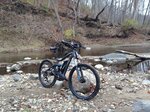Thank you for sharing! I just got back from the Trek dealer. They don't have the new RAIL models yet but they encouraged me to get the feel of a mountain bike. I sat on a FUEL model and was impressed by the suspension system. Another feature that I liked was the ease of lowering the seat to dismount. On the fly it can be raised as well. I am easily impressed because I am in learning mode. As it was set up on the floor it was a bit "bouncy" but he assured me that it could be tuned to the suspension level that I was comfortable with. I was shocked to find that the new Allant models do not have a front fork suspension system. Perhaps one can be installed. I am also suspicious of the gear ratios of the mtn. bike vs street bike. Lot to learn before jump. Thank you!
I am an avid mountain biker and ebike commuter. My ebike is a full rigid city bike (Izip Moda) with 2.4 tires, which serves my purposes quite well. I would not personally consider a mt bike for city riding just because you are introducing unnecessary weight and complications that are likely not needed. Bare in mind that the suspension and pivot points will require additional maintenance and add considerable cost. I would look at a rigid city bike with front fork and suspension post vs a mt bike, but your results may vary.


